Analyses related to the development of DSM-5 criteria for substance use related disorders: 1. Toward amphetamine, cocaine and prescription drug use disorder continua using Item Response Theory
- PMID: 21963414
- PMCID: PMC3272309
- DOI: 10.1016/j.drugalcdep.2011.09.004
Analyses related to the development of DSM-5 criteria for substance use related disorders: 1. Toward amphetamine, cocaine and prescription drug use disorder continua using Item Response Theory
Abstract
Background: Prior research has demonstrated the dimensionality of alcohol, nicotine and cannabis use disorders criteria. The purpose of this study was to examine the unidimensionality of DSM-IV cocaine, amphetamine and prescription drug abuse and dependence criteria and to determine the impact of elimination of the legal problems criterion on the information value of the aggregate criteria.
Methods: Factor analyses and Item Response Theory (IRT) analyses were used to explore the unidimensionality and psychometric properties of the illicit drug use criteria using a large representative sample of the U.S. population.
Results: All illicit drug abuse and dependence criteria formed unidimensional latent traits. For amphetamines, cocaine, sedatives, tranquilizers and opioids, IRT models fit better for models without legal problems criterion than models with legal problems criterion and there were no differences in the information value of the IRT models with and without the legal problems criterion, supporting the elimination of that criterion.
Conclusion: Consistent with findings for alcohol, nicotine and cannabis, amphetamine, cocaine, sedative, tranquilizer and opioid abuse and dependence criteria reflect underlying unitary dimensions of severity. The legal problems criterion associated with each of these substance use disorders can be eliminated with no loss in informational value and an advantage of parsimony. Taken together, these findings support the changes to substance use disorder diagnoses recommended by the American Psychiatric Association's DSM-5 Substance and Related Disorders Workgroup.
Published by Elsevier Ireland Ltd.
Conflict of interest statement
There are no conflicts of interest.
Figures

 Tolerance
Tolerance  Withdrawal
Withdrawal  Larger/longer
Larger/longer  Quit/control
Quit/control  Time spent
Time spent  Activities given up
Activities given up  Physical/psychological
Physical/psychological  Neglect roles
Neglect roles  Hazardous use
Hazardous use  Social/interpersonal
Social/interpersonal  Legal Problems Figure 1b. Criterion Response Curves: Cocaine
Legal Problems Figure 1b. Criterion Response Curves: Cocaine  Tolerance
Tolerance  Withdrawal
Withdrawal  Larger/longer
Larger/longer  Quit/control
Quit/control  Time spent
Time spent  Activities given up
Activities given up  Physical/psychological
Physical/psychological  Neglect roles
Neglect roles  Hazardous use
Hazardous use  Social/interpersonal
Social/interpersonal  Legal Problems
Legal Problems
 Tolerance
Tolerance  Withdrawal
Withdrawal  Larger/longer
Larger/longer  Quit/control
Quit/control  Time spent
Time spent  Activities given up
Activities given up  Physical/psychological
Physical/psychological  Neglect roles
Neglect roles  Hazardous use
Hazardous use  Social/interpersonal
Social/interpersonal  Legal Problems Figure 2b. Criterion Response Curves: Tranquilizers
Legal Problems Figure 2b. Criterion Response Curves: Tranquilizers  Tolerance
Tolerance  Withdrawal
Withdrawal  Larger/longer
Larger/longer  Quit/control
Quit/control  Time spent
Time spent  Activities given up
Activities given up  Physical/psychological
Physical/psychological  Neglect roles
Neglect roles  Hazardous use
Hazardous use  Social/interpersonal
Social/interpersonal  Legal Problems Figure 2c. Criterion Response Curves: Opioids
Legal Problems Figure 2c. Criterion Response Curves: Opioids  Tolerance
Tolerance  Withdrawal
Withdrawal  Larger/longer
Larger/longer  Quit/control
Quit/control  Time spent
Time spent  Activities given up
Activities given up  Physical/psychological
Physical/psychological  Neglect roles
Neglect roles  Hazardous use
Hazardous use  Social/interpersonal
Social/interpersonal  Legal Problems
Legal ProblemsSimilar articles
-
Dimensionality of hallucinogen and inhalant/solvent abuse and dependence criteria: implications for the Diagnostic and Statistical Manual of Mental Disorders-Fifth Edition.Addict Behav. 2011 Sep;36(9):912-8. doi: 10.1016/j.addbeh.2011.04.006. Epub 2011 May 28. Addict Behav. 2011. PMID: 21621334 Free PMC article.
-
Analyses related to the development of DSM-5 criteria for substance use related disorders: 2. Proposed DSM-5 criteria for alcohol, cannabis, cocaine and heroin disorders in 663 substance abuse patients.Drug Alcohol Depend. 2012 Apr 1;122(1-2):28-37. doi: 10.1016/j.drugalcdep.2011.09.005. Epub 2011 Oct 2. Drug Alcohol Depend. 2012. PMID: 21963333 Free PMC article.
-
Item response theory analyses of DSM-IV and DSM-5 stimulant use disorder criteria in an American Indian community sample.Drug Alcohol Depend. 2014 Feb 1;135:29-36. doi: 10.1016/j.drugalcdep.2013.10.010. Epub 2013 Oct 23. Drug Alcohol Depend. 2014. PMID: 24200103 Free PMC article.
-
Substance use disorders: Diagnostic and Statistical Manual of Mental Disorders, fourth edition (DSM-IV) and International Classification of Diseases, tenth edition (ICD-10).Addiction. 2006 Sep;101 Suppl 1:59-75. doi: 10.1111/j.1360-0443.2006.01584.x. Addiction. 2006. PMID: 16930162 Review.
-
Extent of illicit drug use and dependence, and their contribution to the global burden of disease.Lancet. 2012 Jan 7;379(9810):55-70. doi: 10.1016/S0140-6736(11)61138-0. Lancet. 2012. PMID: 22225671 Review.
Cited by
-
Drug use on both sides of the US-Mexico border.Salud Publica Mex. 2018 Jul-Aug;60(4):451-461. doi: 10.21149/8603. Salud Publica Mex. 2018. PMID: 30137947 Free PMC article.
-
Frequency of Cannabis Use Among Primary Care Patients in Washington State.J Am Board Fam Med. 2017 Nov-Dec;30(6):795-805. doi: 10.3122/jabfm.2017.06.170062. J Am Board Fam Med. 2017. PMID: 29180554 Free PMC article.
-
Substance Use and Cumulative Exposure to American Society: Findings From Both Sides of the US-Mexico Border Region.Am J Public Health. 2016 Jan;106(1):119-27. doi: 10.2105/AJPH.2015.302871. Epub 2015 Nov 12. Am J Public Health. 2016. PMID: 26562124 Free PMC article.
-
The National Epidemiologic Survey on Alcohol and Related Conditions (NESARC) Waves 1 and 2: review and summary of findings.Soc Psychiatry Psychiatr Epidemiol. 2015 Nov;50(11):1609-40. doi: 10.1007/s00127-015-1088-0. Epub 2015 Jul 26. Soc Psychiatry Psychiatr Epidemiol. 2015. PMID: 26210739 Free PMC article. Review.
-
Nonmedical Prescription Opioid Use and DSM-5 Nonmedical Prescription Opioid Use Disorder in the United States.J Clin Psychiatry. 2016 Jun;77(6):772-80. doi: 10.4088/JCP.15m10386. J Clin Psychiatry. 2016. PMID: 27337416 Free PMC article.
References
-
- American Psychiatric Association. Draft Criteria. 5. American Psychiatric Association; Washington, D.C: 2011. Diagnostic and Statistical Manual of Mental Disorder.
-
- American Psychiatric Association. Diagnostic and Statistical Manual of Mental Disorder. 4. American Psychiatric Association; Washington, D.C: 1994.
-
- Bentler PM. Comparative fit indexes in structural models. Psychol Bull. 1990;107:203–246. - PubMed
-
- Bock RD, Aitkin M. Marginal maximum likelihood estimation of item parameters: application of an EM algorithm. Psychometrika. 1981;46:443–445.
-
- Bollen KA. Structural Equations with Latent Variables. Wiley; New York, NY: 1989.
Publication types
MeSH terms
Substances
Grants and funding
LinkOut - more resources
Full Text Sources
Medical

